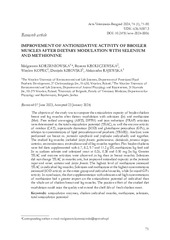Prikaz osnovnih podataka o dokumentu
Improvement of antioxidative activity of broiler muscles after dietary modulation with selenium and methionine
| dc.creator | Korzeniowska, Malgorzata | |
| dc.creator | Kroliczewska, Bozena | |
| dc.creator | Kopec, Wieslaw | |
| dc.creator | Kirovski, Danijela | |
| dc.creator | Rajewska, Aleksandra | |
| dc.date.accessioned | 2024-04-04T10:43:18Z | |
| dc.date.available | 2024-04-04T10:43:18Z | |
| dc.date.issued | 2024 | |
| dc.identifier.issn | 0350-2457 | |
| dc.identifier.uri | https://vet-erinar.vet.bg.ac.rs/handle/123456789/3802 | |
| dc.description.abstract | The objective of the study was to compare the antioxidative capacity of broiler chicken breast and leg muscles after dietary modulation with selenium (Se) and methionine (Met). Free radical scavenging (ABTS, DPPH) and iron reduction (FRAP) activities were determined as the total antioxidative potential (TEAC), as well the enzyme activity of catalase (CAT), superoxide dismutase (SOD) and glutathione peroxidase (GPx), in relation to concentrations of lipid peroxidation end products (TBARS). Analyses were performed on breast m. pectoralis superfi cialis and profundus individually and together. The studied leg muscles included biceps femoris, gastrocnemicus, iliotiobialis, peroneus longus, sartorius, semimembranosus, semitendinosus and all leg muscles together. Flex broiler chickens were fed diets supplemented with 6.7, 8.2, 9.7 and 11.2 g DL-methionine/kg feed and Se as sodium selenite and selenized yeast at 0.26, 0.38 and 0.50 mg Se/kg. Greater TEAC and enzyme activities were observed in leg than in breast muscles. Selenium did not change TEAC in muscles sets, but improved antiradical capacity in the pectoralis major and minor, sartorius and biceps femoris. The highest level of methionine increased TEAC in individual leg muscles. Selenium and methionine at the highest concentrations increased SOD activity in the entire group and individual muscles, while Se raised GPx activity. In conclusion, the diet supplementation with selenium and high concentrations of methionine had a greater impact on the antioxidative potential of individual than the whole set of chicken breast and leg muscles. The positive effect of the studied diet modulation could raise the quality and extend the shelf-life of fresh chicken meat. | sr |
| dc.language.iso | en | sr |
| dc.publisher | Beograd : Fakultet veterinarske medicine | sr |
| dc.relation | Polish Ministry of Science, the National Science Centre in Poland for fi nancial supporting of the project no N N312 253938 | sr |
| dc.rights | openAccess | sr |
| dc.rights.uri | https://creativecommons.org/licenses/by/4.0/ | |
| dc.source | Acta Veterinaria | sr |
| dc.subject | antioxidative enzymes, | sr |
| dc.subject | chicken individual muscles | sr |
| dc.subject | methionine | sr |
| dc.subject | selenium | sr |
| dc.subject | total antioxidative potential | sr |
| dc.title | Improvement of antioxidative activity of broiler muscles after dietary modulation with selenium and methionine | sr |
| dc.type | article | sr |
| dc.rights.license | BY | sr |
| dc.citation.volume | 74 | |
| dc.citation.issue | 1 | |
| dc.citation.spage | 71 | |
| dc.citation.epage | 90 | |
| dc.identifier.doi | 10.2478/acve-2024-0006 | |
| dc.identifier.fulltext | http://veterinar.vet.bg.ac.rs/bitstream/id/11378/bitstream_11378.pdf | |
| dc.type.version | publishedVersion | sr |

